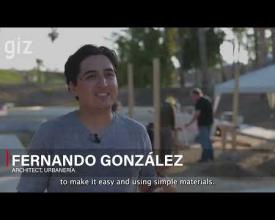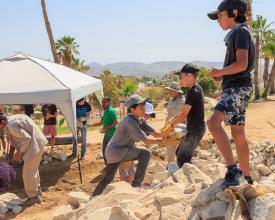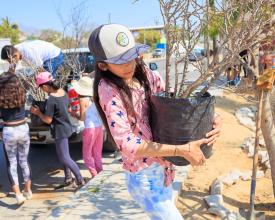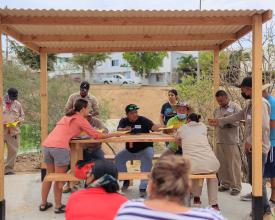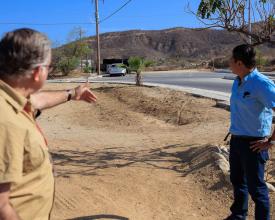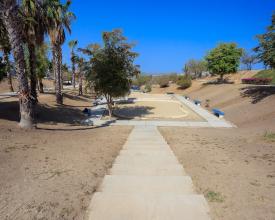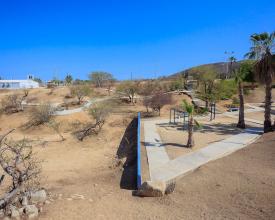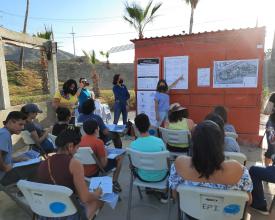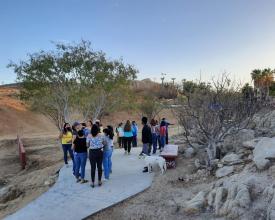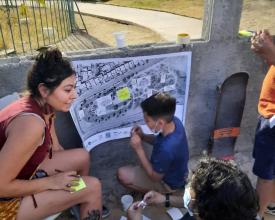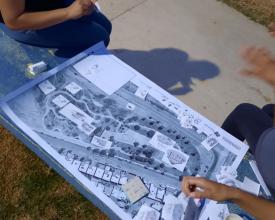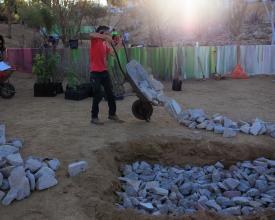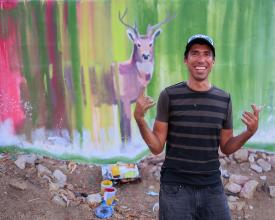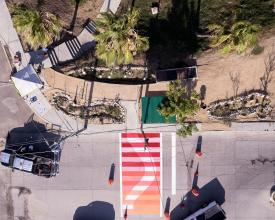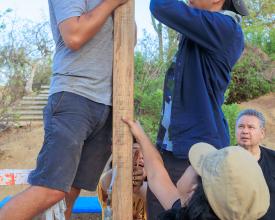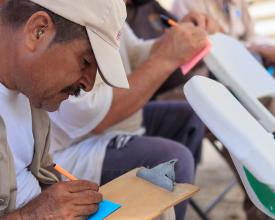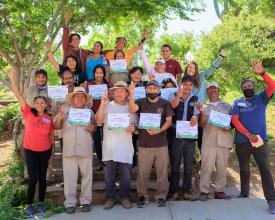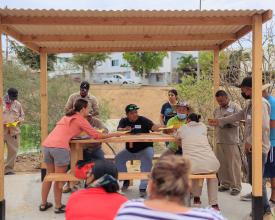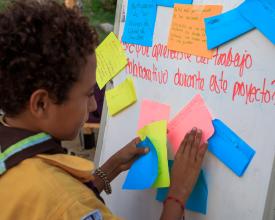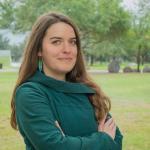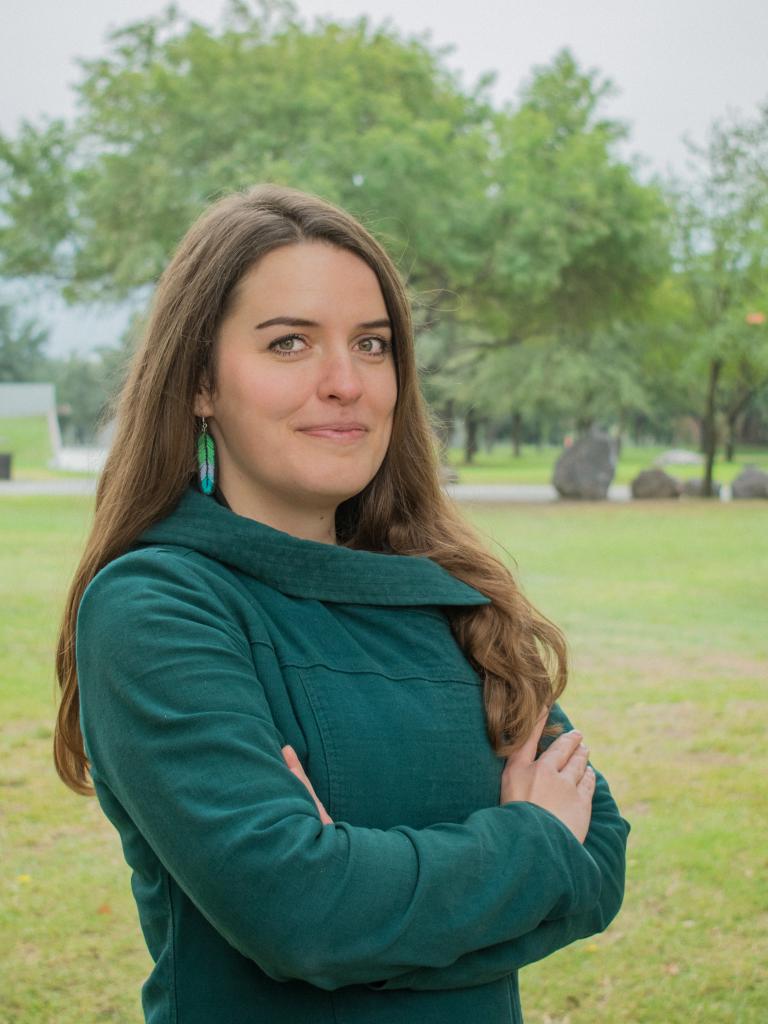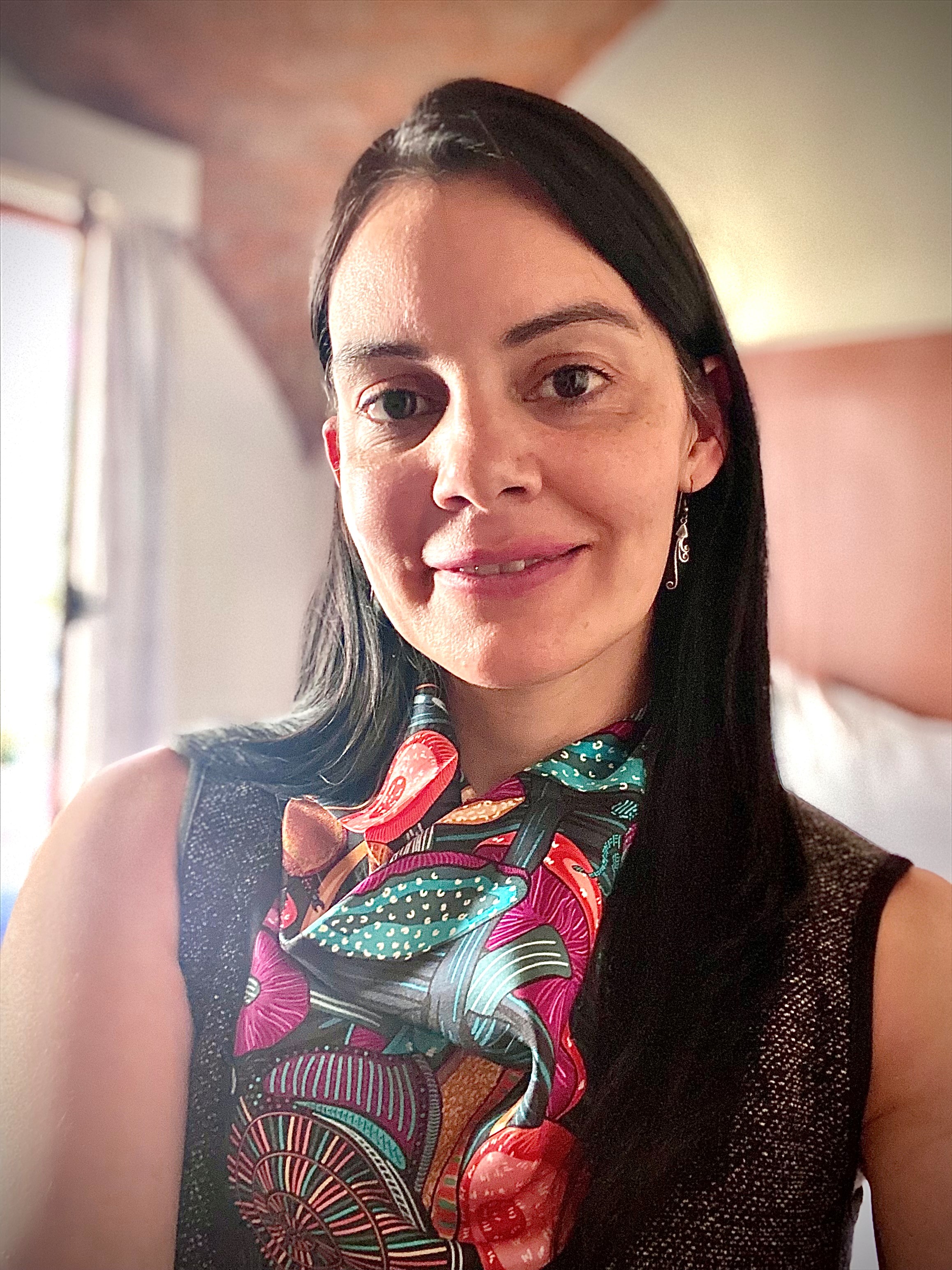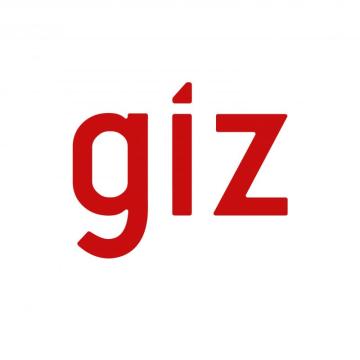
Our Resilient Neighbourhood
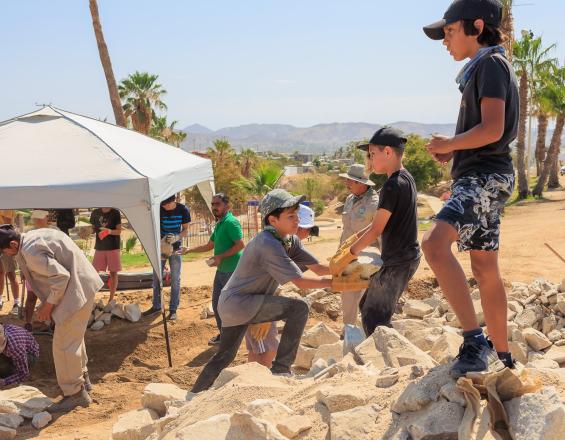
In order to improve the resilience of a neighborhood in the coastal city of San José del Cabo and enhance the citizens' quality of life, this project rehabilitated a multifunctional, safe, and inclusive public space. The initiative "Our resilient neighborhood" brought together the municipality, the local community and allied organizations for a co-creation process. Through volunteer groups that include women and youth, the initiative developed a multifunctional green space and a community pavilion using local low-emission materials, and also provided capacity building on financial education and first aid. The newly established green infrastructure promotes biodiversity and addresses the water and climate issues in the area by providing watersheds, infiltration, runoff areas and native vegetation. The residents have been encouraged to appropriate the public space through tactical urbanism. The park now provides a space for educational, cultural and sports activities.
Context
Challenges addressed
Today, 80 per cent of all Mexicans live in cities. The concentration of large populations in highly dense urban areas brings about critical issues for Mexican cities and their citizens; traffic jams, air and noise pollution, lack of sufficient green infrastructure and inclusive public spaces are
just some to mention. The effects of climate change compounded by the overexploitation of natural resources have left many rapidly growing urban areas in Mexico threatened by water scarcity. Los Cabos, a coastal municipality in Baja California Sur with the highest urbanization rate in Mexico, which is closely linked to tourism, needs solutions to these challenges. Due to the concentration of infrastructure on the coastal strip in this region, neighborhoods further away from the coast are confronted with intensified social, economic, and environmental issues. Women, youth and children suffer more vulnerability, and therefore their perspective needs to be specifically addressed.
Location
Process
Summary of the process
- a criteria-based site selection ensures that the objectives, involved actors, financial resources and available measures can generate the desired outcome
- the integration of the community ensures that their needs are taken into account in every phase and facilitates their hands-on support in the implementation phase and for maintenance of the public space
Building Blocks
Site selection and socio-environmental analysis
The overall objective of the initiative was to increase the resilience of a local neighborhood. Therefore, an adequate implementation site had to be identified, with the potential to increase the quality of life of the local community and to showcase solutions to typical environmental problems that are present in the city of San José del Cabo.
The implementation site was selected by the Municipal Planning Institute of Los Cabos, by taking into consideration the following selection criteria:
- accessibility to the site
- available allies
- presence of environmental problems to be addressed
- crime rate
- support by the local government
- available services (electricity, water supply)
- available funding
After the site was selected, a socio-environmental analysis and a topographical survey was conducted by the Urban Oasis Alliance (consisting of the organizations Niparajá, Urbanería, EPI). The objective of these analyses was to identify the current status of the park, including the the environmental services it provided, the environmental and social risks that were present in the space, the user types, the different ways in which the community was using the park, perceived and existing risks and other social and environmental factors.
Enabling factors
- Committed local government to support the process of the site selection and definition of the objectives of the initiative
- Applying adequate criteria for selecting the site
- Using this planning phase for forming alliances with governmental entities, local organizations, the local community and other relevant stakeholders
Lesson learned
- The preparation phase requieres almost as much time as the actual implementation
- The criteria that are applied to select the site have to match the overall and specific objectives of the initiative
- The implementation partners should be involved from the very beginning, hence, during the selection of the site
Community integration and co-creation process
The integration of the local community into the entire process of transforming the park from early planning stages onward was a key action. Different mechanisms can be applied to reach out to the neighborhood, including: WhatsApp groups, Facebook groups, distributing flyers, virtual meetings that lead up to the actual physical planning and implementation meetings. It is also recommendable to reach out to already existing groups and organizations, in the case of the Park Pedro Sánchez, groups of scouts, local schools and a neighborhood committee that was formed as part of the outreach process.
During a co-design workshop in the park, the community described the current use of the park and expressed their vision, ideas and desires for a transformation of the park. Maps and post-its with happy and sad emoticons were used to visually express the perspective of the community with regards to specific sites within the park and the current use. In order to make collective decision about the future use of every site, people voted on each option. The final map represents the decisions of the co-design workshop.
Enabling factors
- Transparency about the available budget and the type of measures that can be financed (management of expectations): if participants propose measures that go beyond the available funding, it is recommended to list them apart for potential future activities.
- Inviting representatives of the municipality to the co-design workshops: in this way, they can engage directly with the community, answer questions and establish a more direct link. At the same time, the municipality is well informed about the advances of the process and can support next steps.
Lesson learned
- It is recommended to create a space for participants to socialize and connect, for example during a meal after the workshop.
- It is important to share the final map and next steps with the community, and make sure that the information also reaches those who were not able to participate in the design workshop
Participatory practical workshops to transform the space and to promote financial and environmental education
The actual construction was implemented through practical and educational workshops with the neighbors, the Public Services Department and partly with contracted workers. The workshops addressed the following measures: 1) green infrastructure and reforestation, 2) urban art and tactical urbanism, and 3) urban furniture. In this way, the park was transformed through joint efforts, while learning about the importance of nature-based solutions and easy measures to implement them in other public spaces or in gardens and other spaces of the community.
In adition, educational workshops were conducted with a local school and a group of scouts to improve the financial education of young people and kids in the community. Another set of workshops was implemented with neighbors and members of an informal neighborhood, with a focus on first aid.
Enabling factors
- High commitment of implementing partners and the municipality
- Know-how of local organizations
- Clear division of roles among implementing partners and the municipality, good coordination among partners
- Activation of other local groups along the way (scouts)
Lesson learned
- Time buffers requiered for unforeseeable events (health and climate related)
- Implement activities outside of heat and hurrican period to ensure participation and safety
Resources
Feedback workshops and maintenance of the park
In order to preserve the functionality and the esthetics of the park, it is important to know how to maintain it. This includes monitoring, the maintenance of green spaces and cleaning.
With regards to monitoring, it is recommended to have communication mechanisms established between the community and the municipality. In this case, the neighborhood committee remains in touch via WhatsApp with the contact person of the Public Services Department and may share observations or ask directly for support in the case of any event.
Furthermore, a list of indicators was established for the monitoring and ensuring the functionality of the green space, with a focus on the vegetation, water infiltration, erosion and shadow areas. The maintenance of the infrastructure of the park (paths, discharges, bins) was also addressed.
During a maintenance workshop with the Public Services Department and members of the local community, roles and responsibilities were divided with regards to the different indicators.
Furthermore, a feedback workshop was conducted with the Public Services Department and the neighbors, in order to capture how both groups perceived the entire process and to integrate their feedback into the methodology of future processes.
Enabling factors
- Having worked with native plants and local materials reduces the necessary effort to maintain the green infrastructure and vegetation over time (for example, after the first year, irrigation may not be necessary anymore)
- Having established a good relationship between the Public Services Department and the community helps to divide roles and to generate commitment
Lesson learned
- Time constraints: it was impossible to arrange a joint maintenance workshop with the neighbors and the Public Services Deparment due to conflicting working schedules. Conducting seperate workshops was not ideal, but the only alternative.
Impacts
Tangible results:
• 8 rain infiltration gardens and 1 absorption well
• 3 picnic areas
• 300 native plants
• 3 murals, 29 benches and 2 pedestrian crossings painted
• 2 access ramps
• 2 modified sandpits
• new trails
• 1 bus stop
Intangible results:
• Neighbors are organized and trained.
• More interaction and communication in the community.
• Increased perception of security in the park.
• Direct communication channels between the community and the municipality.
• Agreement on roles and responsibilities for maintaining the park.
• Public Services was trained in the sustainable management of public parks.
Beneficiaries
- The community of the neighborhood Colinas San José in San José del Cabo
- The municipality, especially the Public Services Department
- Public schools and a group of scouts
Sustainable Development Goals
Story
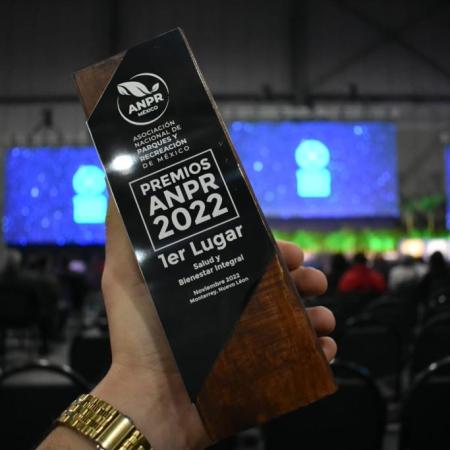
For generating change, it requieres a common goal and joint efforts. This initiative and the many-sided results it achieved were possible thanks to the participation of neighbors, scout groups, schools and the collaboration of more than 10 local and international organizations, institutions and the municipality.
The efforts were recognized through the 1st prize of the World Urban Parks Congress Award 2022, in the category of health and wellbeing.
These were the main contributions of each organization:
Municipality: permits, plant donations, cleanups, removal of structures
Niparajá, Urbanería, EPI: socio-environmental and topographic analysis, participatory workshops on the design of the space, green infrastructure, urban art, tactical urbanism, urban furniture and maintenance
ASA: capacity building on first aid
Philanthropiece: workshops on financial education and sustainable consumption
GIZ: management of funds, coordination with partners, communication products

